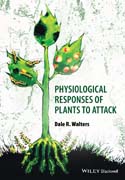
Despite the research effort put into controlling pathogens, pestsand parasitic plants, crop losses are still a regular feature ofagriculture worldwide. This makes it important to manage the cropappropriately in order to maximise yield. Understanding therelationship between the occurrence and severity of attack, and theresulting yield loss, is an important step towards improved cropprotection. Linked to this, is the need to better understand themechanisms responsible for reductions in growth and yield inaffected crops. Physiological Responses of Plants to Attack is unique because itdeals with the effects of different attackers pathogens,herbivores, and parasitic plants, on host processes involved ingrowth, reproduction, and yield. Coverage includes effects onphotosynthesis, partitioning of carbohydrates, water and nutrientrelations, and changes in plant growth hormones. Far from beingsimply a consequence of attack, the alterations in primarymetabolism reflect a more dynamic and complex interaction betweenplant and attacker, sometimes involving re–programming of plantmetabolism by the attacker. Physiological Responses of Plants to Attack is written anddesigned for use by senior undergraduates and postgraduatesstudying agricultural sciences, applied entomology, cropprotection, plant pathology and plant sciences. Biological andagricultural research scientists in the agrochemical and cropprotection industries, and in academia, will find much of use inthis book. All libraries in universities and researchestablishments where biological and agricultural sciences arestudied and taught should have copies of this exciting book ontheir shelves INDICE: Preface xi.1 The Interaction Between a Plant and Its Attacker 1.1.1 Introduction 1.1.2 Different types of attacker 1.1.3 Symptoms exhibited by plants following attack 20.1.4 Conclusions 21.Recommended reading 21.References 22.2 Growth, Development and Yield of Infected and InfestedPlants and Crops 24.2.1 Introduction 24.2.2 Effects of pathogens on growth, development and yield 24.2.3 Effects of nematodes on growth, development and yield 29.2.4 Effects of herbivores on growth, development and yield30.2.5 Effects of parasitic plants on growth, development and yield36.2.6 Conclusions 37.Recommended reading 38.References 38.3 Photosynthesis in Attacked Plants and Crops 41.3.1 Introduction 41.3.2 Photosynthesis in diseased plants 41.3.3 Photosynthesis in plants infected with nematodes 61.3.4 Photosynthesis in plants infested with insects 65.3.5 Photosynthesis in plants infected with parasitic plants73.3.6 The caring robber? hardly! 80.3.7 Conclusions 81.Recommended reading 81.References 81.4 Respiration in Plants Interacting with Pathogens, Pests andParasitic Plants 88.4.1 Introduction 88.4.2 Effects of attack on respiration 90.4.3 Photorespiration in attacked plants 105.4.4 Conclusion 108.Recommended reading 109.References 109.5 Effects on Carbohydrate Partitioning and Metabolism114.5.1 Introduction 114.5.2 Carbohydrate partitioning and metabolism in plants infectedby pathogens 114.5.3 Carbohydrate metabolism and partitioning inplant insect herbivore interactions 122.5.4 Carbohydrate metabolism and partitioning in interactionsbetween plants and parasitic angiosperms 124.5.5 Conclusions 125.Recommended reading 126.References 127.6 Water Relations of Plants Attacked by Pathogens, InsectHerbivores and Parasitic Plants 130.6.1 Introduction 130.6.2 Effects of pathogens on plant water relations 130.6.3 Effects of nematodes on plant water relations 139.6.4 Water relations in plants infested with insect herbivores140.6.5 Effects of parasitic angiosperms 145.6.6 Conclusions 148.Recommended reading 149.References 149.7 Mineral Nutrition in Attacked Plants 153.7.1 Introduction 153.7.2 Mineral nutrition in plant pathogen interactions156.7.3 Mineral nutrition in plant nematode interactions164.7.4 Mineral nutrition in plant insect interactions 165.7.5 Mineral nutrition in interactions between plants andparasitic angiosperms 170.7.6 Conclusions 175.Recommended reading 176.References 176.8 Hormonal Changes in Plants Under Attack 181.8.1 Introduction 181.8.2 Hormonal changes in plants responding to pathogens 181.8.3 Hormonal changes in plants responding to insect attack198.8.4 Hormonal changes in plants infected with parasitic plants201.8.5 Conclusions 205.Recommended reading 207.References 207.9 Bringing It Together: Physiology and Metabolism of theAttacked Plant 215.9.1 Introduction 215.9.2 Metabolic reprogramming in plant pathogen interactions215.9.3 Metabolic reprogramming in interactions between plant andparasitic nematodes 220.9.4 Metabolic reprogramming in plant insect interactions221.9.5 Metabolic reprogramming in interactions between plants andparasitic angiosperms 222.9.6 Metabolic reprogramming is the plant just abystander in compatible interactions? 222.9.7 Plant responses to attack a look to the future222.Recommended reading 223.References 223.Index 225
- ISBN: 978-1-4443-3329-9
- Editorial: Wiley–Blackwell
- Encuadernacion: Rústica
- Páginas: 248
- Fecha Publicación: 21/04/2015
- Nº Volúmenes: 1
- Idioma: Inglés
